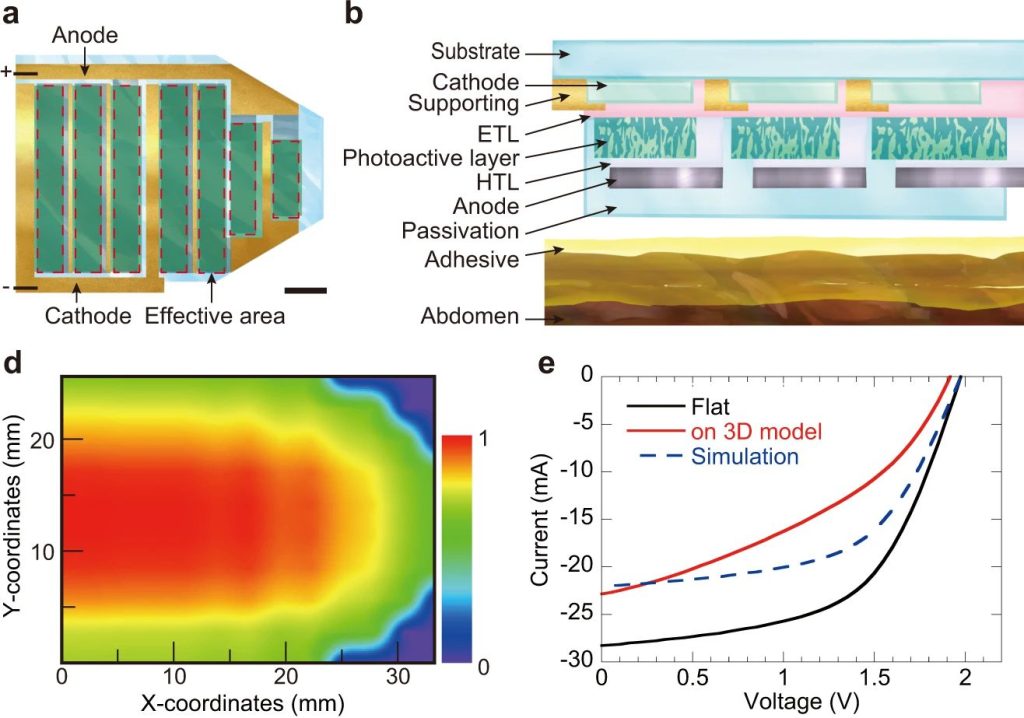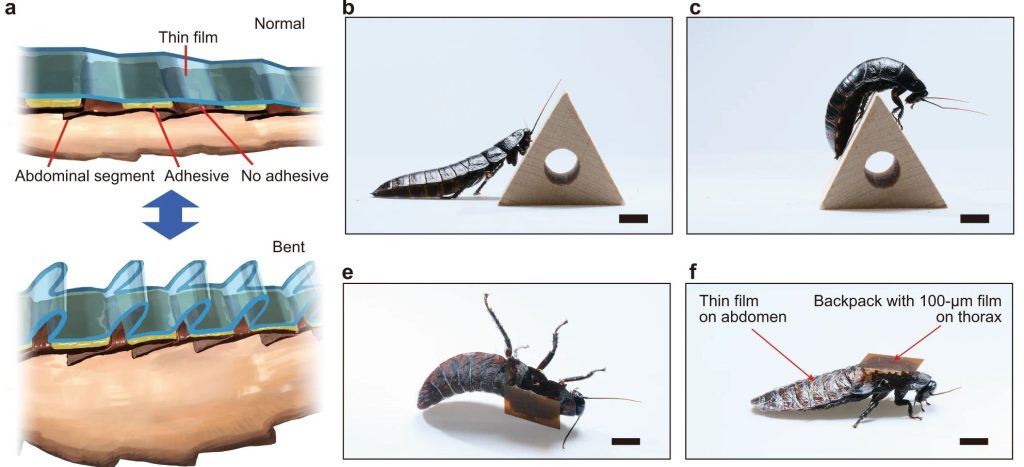Researchers at Japan’s RIKEN Center for Emergent Matter Science (CEMS) have used 3D printing to create a device which transforms cockroaches into remote control cyborgs.
3D printed from an elastic polymer that allows it to follow the curved surface of the insect’s thorax, the team’s tiny backpack enables the carrying of a locomotion control module and solar cell. These, in turn, provide users with a means of electrically stimulating a cockroach’s cercus to issue navigational commands, and preventing it from breaking free by keeping its battery charged via the sun.
“Keeping the battery adequately charged is fundamental – nobody wants a suddenly out-of-control team of cyborg cockroaches roaming around,” says the RIKEN scientific research institute’s Masataka Sasabe. “While it’s possible to build docking stations for recharging the battery, the need to return and recharge could disrupt time-sensitive missions. Therefore, the best solution is to include an onboard solar cell that can continuously ensure that the battery stays charged.”

Cyborg search and rescue insects?
Citing Nanyang Technological University cyborg insect research carried out last year, the CEMS scientists say controllable bugs hold significant potential as future urban search and rescue vehicles. Theoretically, the team believe the little critters could be used to enter areas too dangerous for humans to access, but they add that storing enough charge to power tiny control devices “remains challenging.”
To prevent such cyborgs from having to continually return to base for charging, the scientists suggest that they be mounted with energy harvesting devices, capable of recharging on the move. While the highest recorded output of an enzymatic biofuel cell is 333 μW, and this has proven sufficient to control cockroaches in previous studies, the CEMS team now say solar power can drive this number up to 10 mW.
With this in mind, the researchers’ project has seen them focus on finding ways to affix solar batteries and navigational devices to insects without giving them too heavy a load to bear, and compromising their “basic behavioral abilities.”
“To integrate devices into small animals with limited surface areas and carry loads, device design and integration strategy of large-area solar cells is required,” explain the CEMS scientists in their research paper. “Because the output power of the solar cell is proportional to the area, both the load of the device and the contact between the device and the moving joints considerably impair motion abilities.”

Turning cockroaches into cyborgs
To maximize the success of their battery and circuit board-carrying device, the scientists designed it to fit the Madagascan cockroach, one of the biggest in the world, with a body up to 7 centimeters long. Manufacturing their backpack using Formlabs’ Form 3 3D printer and Elastic 50A material provided it with the flexibility to conform to the insect’s curved body, while making it an ideal mounting point.
Onto their backpack, the researchers found they were able to attach a 4 µm-thick organic solar cell module to one of the insect’s abdomens, which after circuit boosting, yielded a power output of 4.2 V. This charge could then be used to power a wireless module capable of receiving signals from an external server, and making the cockroach comply with them via electric shocks to its navigational cercus.
In early attempts to use the device to control cockroaches through obstacle courses, the solar cells proved too thick or rigidly attached, in a way that slowed them down and made it tricky for them to self-right. However, by replacing a 3 µm-thick film holding the cell in place with a resin adhesive, the team found their insect cyborgs were a lot more nimble.
When it came to charging performance, testing also showed that the solar cell module was capable of powering the device for two hours after a full charge. As a result, the researchers concluded that their approach is an effective “design strategy for mounting electronics” onto cockroaches, which could help “expand the range of activity and realize diverse functions for cyborg insects,” moving forwards.

Creating cyborg cockroaches may be on the niche side of 3D printing research, but the technology has also been used in the development of human mind-controlling and brain-treating devices. Renishaw has made significant progress with its 3D printed neuroinfuse drug delivery device, a platform it’s developing with Herantis Pharma to treat Parkinson’s, which has now gone through clinical trials.
Elsewhere, in a project carried out at Aston University last year, scientists explored the potential of 3D bioprinting in treating neurological conditions. As part of the EU-backed Meso-Brain project, the team generated custom 3D printed stem-cell-derived neurons, which could be used to develop a new generation of disease modeling and testing tools.
The researchers’ findings are detailed in their paper titled “Integration of body-mounted ultrasoft organic solar cell on cyborg insects with intact mobility.” The study was co-authored by Yujiro Kakei, Shumpei Katayama, Shinyoung Lee, Masahito Takakuwa, Kazuya Furusawa, Shinjiro Umezu, Hirotaka Sato, Kenjiro Fukuda and Takao Someya.
To stay up to date with the latest 3D printing news, don’t forget to subscribe to the 3D Printing Industry newsletter or follow us on Twitter or liking our page on Facebook.
While you’re here, why not subscribe to our Youtube channel? featuring discussion, debriefs, video shorts and webinar replays.
Are you looking for a job in the additive manufacturing industry? Visit 3D Printing Jobs for a selection of roles in the industry.
Featured image shows a cockroach wearing the researchers’ 3D printed backpack. Photo via the RIKEN CEMS.


